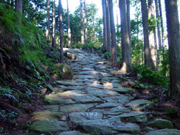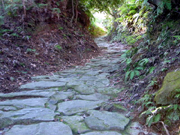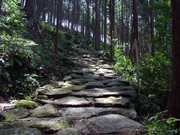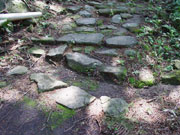|
|
 |
| Why were the stone paths
created? |
 The
stone paths are the icon of Kumano Kodo, but why were they created?
As you can see by walking along Kumano Kodo, it's extremely difficult
to make stone paths since they are located on the mountain slopes.There
must have been some reasons why they had to be created. The
stone paths are the icon of Kumano Kodo, but why were they created?
As you can see by walking along Kumano Kodo, it's extremely difficult
to make stone paths since they are located on the mountain slopes.There
must have been some reasons why they had to be created. |
 |
 |
To protect paths from heavy rain |
 The
area of Higashikishu is in famous in Japan for heavy rain .
It rains very hard in certain seasons. The
area of Higashikishu is in famous in Japan for heavy rain .
It rains very hard in certain seasons.
The earth paths would be washed away and destroyed by the rain.
It's considered that the stone paths were created to protect
the trails.
The
stones are laid without any gaps to improve the paths' strength.
Still, the stone paths won't last forever. Since they were used
as roads for people's lives until the beginning of the Showa
period, they used to be repaired when they broke. The differences
in dates may be seen in the different methods of construction.
|
 |
To make
the slopes easier |
 Kumano
Kodo are rugged paths going over many mountain passes, so the
incline is rather hard. It's also considered that the stone
paths were created to make walking easier. By digging meters
into the ground, the plane (Horiwari) was made and the stones
were laid to make the incline milder. Kumano
Kodo are rugged paths going over many mountain passes, so the
incline is rather hard. It's also considered that the stone
paths were created to make walking easier. By digging meters
into the ground, the plane (Horiwari) was made and the stones
were laid to make the incline milder.
Also some people used to pass by palanquin a long time ago,
and it was not possible for them to get over steep slopes.
This is one reason why you can't find any stone paths on flat
roads, but see stone fences reinforcing the shoulders on the
valley sides. |
 |
To maintain
the road |
Since the climate is mild, the
earth paths can become overgrown with grasses. The stone paths
prevent the weeds regardless if walkers pass there or not.
This is another reason why the
stones are laid without any gaps. |
|
 |
|
How were the stone paths made?
|
 |
 |
By
digging into the ground |
 |
From the
bottom up |
 The
stone paths have a variety of forms like steps
and flat
spans.. The differences The
stone paths have a variety of forms like steps
and flat
spans.. The differences
in shapes are related to the area and time they were created
in.
Along flat spans, the
stones were laid from the bottom up, with successively higher
levels braced against underlying stones. The lack of gaps increases
the strength of the paths. |
 |
Where did
the stones come from? |
| It's considered that most of
the stones for the paths were procured in the local region.
Kumano Acid Rocks ( Kurounmokaogan ) are generally used, which
are usually found in the mountains of Higashikishu. Perhaps
the stones scattered around the roads were used. It's said that
you can find these stones most likely in the mountains dozens
of meters away from the paths, the stones nearby the roads were
used. |
 |
The method
of construction |
Here are some imaginary figures
based on the reports by people who observed the maintenance
of stone paths in Magose Toge. There are just for reference,
Since not all stone paths were made in this way. |
The slashed part shows the mountain
ground.
The stone path will be made on this slope. |
 |
|
|
| First, dig the ground from many
of centimeters to a few meters in depth. (The dotted line shows
the previous ground level) |
 |
|
|
| l Lay the stones for the foundation. |
 |
|
|
| l Spread soil (or similar) on
the stones to make the foundation firm. |
 |
|
|
| l Lay flat stones on the foundation.
To brace the upper stones firmly, lay stones from the bottom
up. The stone path will be a little lower than the original
ground. |
 |
| |
|
 |
|
When were the stone paths made?
|
It's hard to tell when the stone paths were made.
When the dedicated maintenance of the Kumano Kodo paths began at the
first half of the 17th century, the stone paths already existed.
Though the paths have been repaired many times since they were created,
they are still maintained today. However, since the ancient process
has been lost, it's difficult to restore them as they were.
It's also hard to tell the differences of each section, as they derive
from the skills of residents of each area or each time period. |
 There are channels of running springwater from the mountain to the
valley rivers which cross the roads. This method is called "Araikoshi"(washing
over), and is seen anywhere along Kumano Kodo , not always on stone
paths. Each cannel is small , but many can be seen along the roads.
There are channels of running springwater from the mountain to the
valley rivers which cross the roads. This method is called "Araikoshi"(washing
over), and is seen anywhere along Kumano Kodo , not always on stone
paths. Each cannel is small , but many can be seen along the roads.
Since Kodo paths weren't used for a long time, most of them were covered
over with soil, however they have been renewed since the recent discovery. |
|
 |




